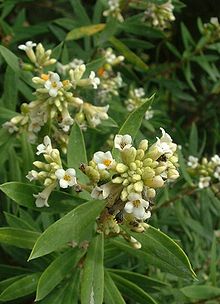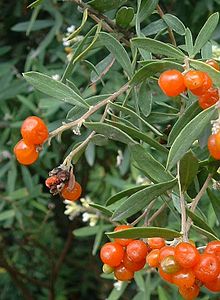- Daphne gnidium
-
Daphne gnidium 
Daphne gnidium Scientific classification Kingdom: Plantae (unranked): Angiosperms (unranked): Eudicots (unranked): Rosids Order: Malvales Family: Thymelaeaceae Genus: Daphne Species: D. gnidium Binomial name Daphne gnidium
L.Daphne gnidium (commonly known as the Flax-Leaved Daphne) is a poisonous evergreen shrub from the Mediterranean region with narrow, dense dark-green foliage and white fragrant flowers.
Contents
Description
Daphne gnidium is characterized by upright branches that grow 1.5 to 2 m (4 ft 10 in to 6 ft 7 in) tall. The dense lanceolate leaves are dark green with sticky undersides. It bears white fragrant flowers in late spring or early summer. The fruits are drupes and are round and red, about 8 mm (0.31 in) in diameter. They are produced during autumn.[1] [2]
Habitat
Daphne gnidium grows well in sandy loam. They are commonly found in fields, woodlands, garrigues, and hillsides. They are native to the areas surrounding the Mediterranean Sea (Southern Europe, Northern Africa, and the Middle East).
Toxicity
Daphne gnidium contains the toxins Mezerein and Daphnetoxin. All parts of the plant is considered highly poisonous. Skin contact with the sap can cause dermatitis [3]
References
- ^ "Daphne gnidium (Flax-leaved daphne)". http://www.shootgardening.co.uk. http://www.shootgardening.co.uk/plant/daphne-gnidiu. Retrieved January 22, 2011.
- ^ "'Daphne gnidium L. (Daphne)". http://www.botanical-online.com. http://www.botanical-online.com/fotosdahpne.htm. Retrieved January 22, 2011.
- ^ "Daphne gnidium L.". http://www.botanical-online.com/. http://www.botanical-online.com/alcaloidesdaphneangles.htm. Retrieved January 22, 2011.
This Malvales-related article is a stub. You can help Wikipedia by expanding it.

